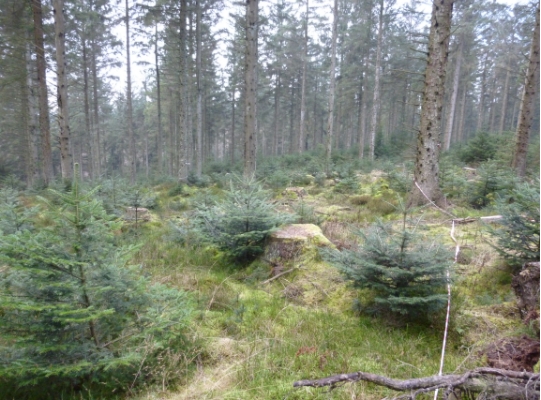Adaptation describes the process of adjustment to the actual or expected effects of climate change, in order to reduce harm or exploit opportunities.
In the context of forestry, it means reducing the impacts of climate change on woodlands, forests and forestry and reducing their vulnerability (i.e. increasing their resilience), as well as utilising trees and forests to reduce the impacts on, and vulnerability of, society to climate change.
For our forests and woodlands to thrive, the risks associated with the changing climate must be assessed, and adaptation measures carefully considered before taking action. The changing climate may provide some opportunities such as a wider species choice and faster tree growth in some locations where other factors are not limiting, so adaptation measures may include harnessing these opportunities.

A more varied age structure and presence of younger trees can help spread risks and provide future options, as seen here in a stand of underplanted uniform shelterwood.
The United Kingdom Forestry Standard (UKFS) advocates a risk-based approach to adaptation, which includes implementing measures to reduce the risk of negative consequences and utilise positive opportunities. This is particularly the case because of the long timeframe associated with management decisions made in forestry.
The latest guidance from the UKFS recommends following the 5-step adaptation framework, which presents a simple management approach from site assessment of risks through to regular monitoring and evaluation of adaptive practice. The approach to adaptation will be site- and risk-specific, depending on the nature and degree of risk, the site management objectives, and the resources available.
A range of approaches to adaptation are possible, including risk avoidance or prevention (reducing exposure), reducing the severity of risk (reducing the degree of hazard), increasing resistance to the impacts of a risk (i.e. reducing vulnerability), and increasing resilience (minimising impacts, supporting recovery, building adaptive capacity – that is, increasing the degree of disturbance the system can recover from).
Planning for the changing climate is a challenge because past approaches are unlikely to lead to the same outcomes in future. Woodland owners and managers should assess the risks that climate change poses, and plan adaptation accordingly. You will find information on the Climate Change Hub to assist you at every stage of the framework, including further information about adaptation measures.
Climate change risk assessment and a national plan for adaptation are requirements under UK laws. The devolved administrations have policies which outline their national adaptation programmes and plans, the details of which can be found on our official country guidance pages.
The UKFS Practice Guide ‘Adapting forest and woodland management to the changing climate’ guides practitioners through the process from assessing climate change risks to implementing adaptation measures.
Printed copies are available to purchase from Forest Research.
Printed copies are available to purchase from Forest Research.
"*" indicates required fields
